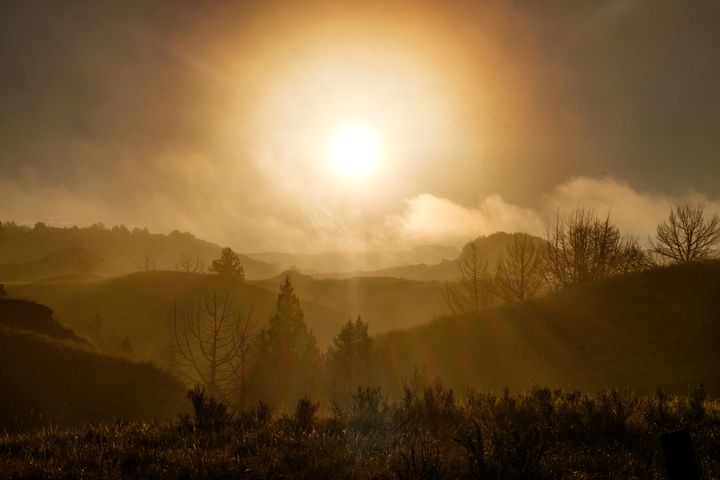
A bold sunrise over Theodore Roosevelt National Park in North Dakota.
North Dakota is not a place you might expect to wow you with wild terrain. As you drive through the remote western part of the state along long two-lane highways, there appears to be nothing in sight but flatland for as far as the eye can see. Then as you near the remote areas surrounding Theodore Roosevelt National Park (TRNP), a rare vestige of wilderness filled with badlands, dense vegetation, grasslands, and diverse wildlife appears out of seemingly nowhere drawing you into its fold.
In 1883, a young Theodore Roosevelt visited the Dakota Territory for the first time to "bag a buffalo." His first visit to the frontier enchanted him so profoundly that it spurred a lifelong love affair with the region and in him a devout conservation ethic was born; and ethic that would shape the future of America's conservation efforts and of the national parks that have served as our nation’s playgrounds for more than 100 years.
He would return many times in his life to reflect and regroup from what he called "the strenuous life" that he led in New York. Ultimately we went there—and to all of the national parks—for the very same reason: to connect with the land and to shake off the effects of a strenuous life.
This park doesn’t get a lot of play on the national stage, mostly because of its out-of-the-way location. Our hope is that this write-up will inspire others to journey there... not only is it among the most historic of all of our federally protected spaces, but it is absolutely lovely as well. With that, we wanted to delve in to some of the reasons why we loved being there.
Three Areas to Explore
TRNP is composed of three park units that are bound together by the Little Missouri River. The north unit is quiet and rugged; the south unit is home to abundant populations of watchable wildlife; and the Elkhorn Ranch, or west unit, is where Teddy Roosevelt lived for nearly 13 years. Drives between the three areas can take several hours each, so plan to devote individual brackets of time to each, with at least a couple days in both the north and south units, and one long afternoon in the Elkhorn unit.
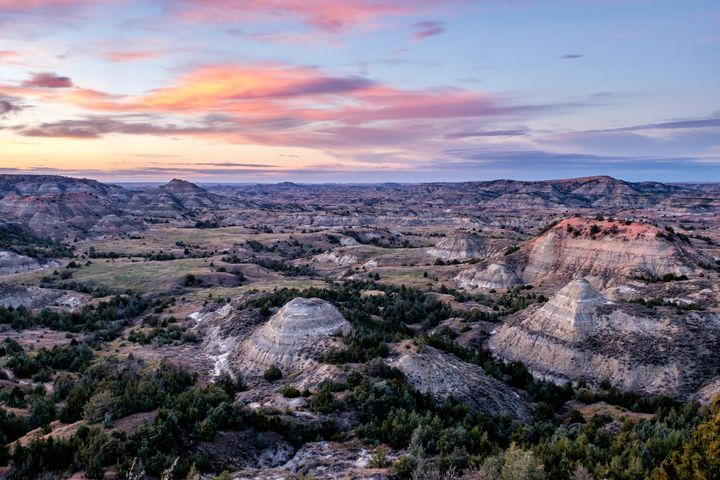
Colorful badland formations and forest at Painted Canyon in the south unit.
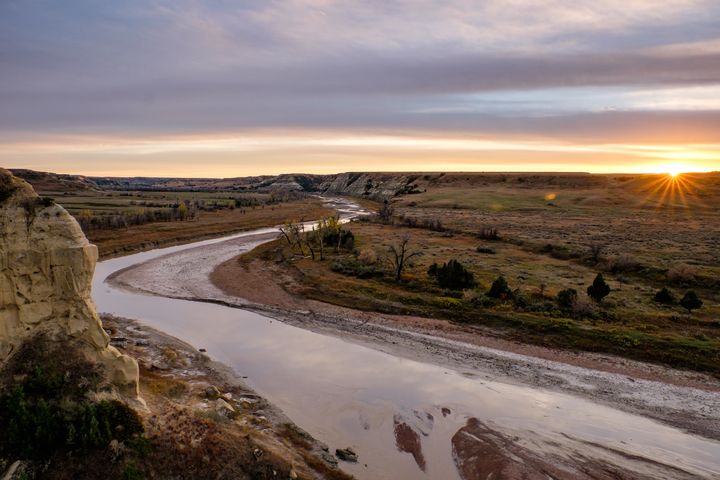
The Little Missouri River as seen fromWind Canyon Overlook in the north unit.
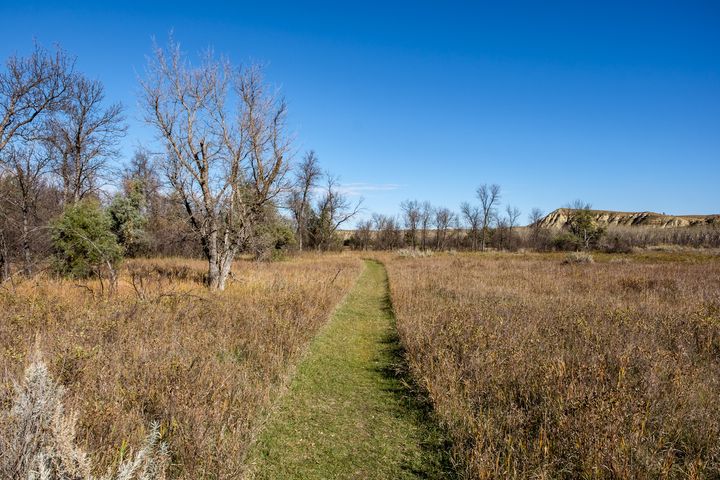
Pathway to where Elkhorn Ranch once stood in the west unit.
Accessible Adventure on the Great Plains
There are scenic drives in the north and south sections of the park, the longest and most popular located in the south unit. It technically only takes about 90 minutes to meander the 36-mile road but with so much to see, it could easily take a full day. In the north unit, a 60-minute drive through the park road winds among soft sandstone formations, forests of cottonwood and juniper trees, and across grasslands hugging the Little Missouri River. There is excellent RV and tent camping at the Juniper Campground near the entrance—a jumping off point to some of the most challenging trails in the park. If you are looking for less challenging routes, you are in luck—there are many easy trails in all three units where you are enfolded by a world of unique landscapes.
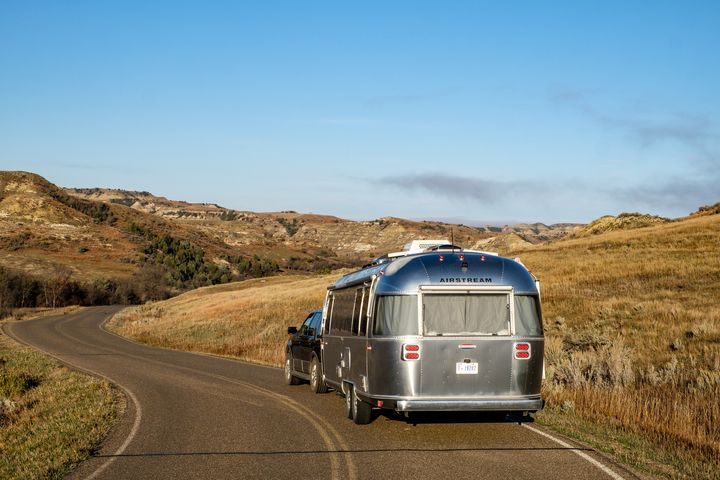
Airstreaming on the scenic park road in the south unit.
Badlands, Petrified Forest, Fossils, and Other Cool Geology
Like its neighboring state of South Dakota, Theodore Roosevelt is home to many colorful badland formations—sedimentary deposits created over the course of 65 million years by the effects of erosion caused by wind, sun, hail, snow, and rain. One unique distinction of the badlands at TRNP is that vegetation grows from and all around them. Tucked into the folds of the badlands are large deposits of petrified wood—massive trees turned to solid quartz over the course of millions of years. At TRNP, you will find the third largest deposit of petrified wood in the United States, following Yellowstone and Petrified Forest national parks. The most concentrated area can be found along the Petrified Forest Loop trail, a 10-mile hike located in the south unit.
While there are several national parks where you can see badlands and petrified wood, there is only one that we know of where you can hike across formations that look like enormous cannonballs made of rock. The aptly named Cannonball Concretions are a truly unusual sight and are located just steps from the Juniper Campground across the park road. And where there are badlands, there are fossils, making TRNP a living laboratory for scientists and paleontologists who visit the area to uncover secrets of Earth’s past.
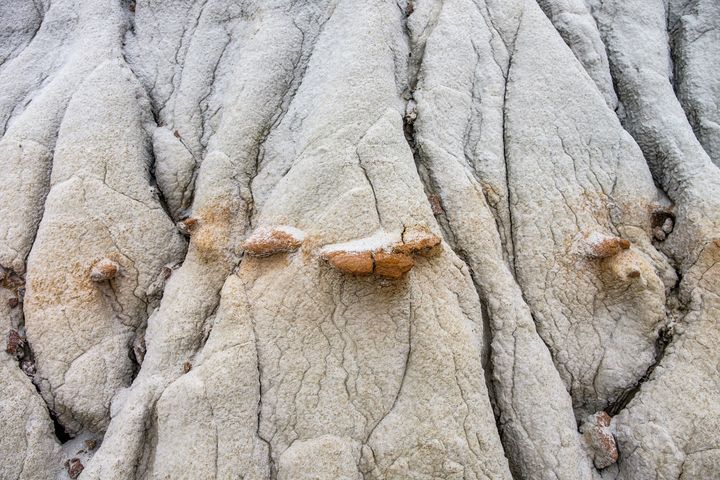
65-million year old badlands in the south unit.
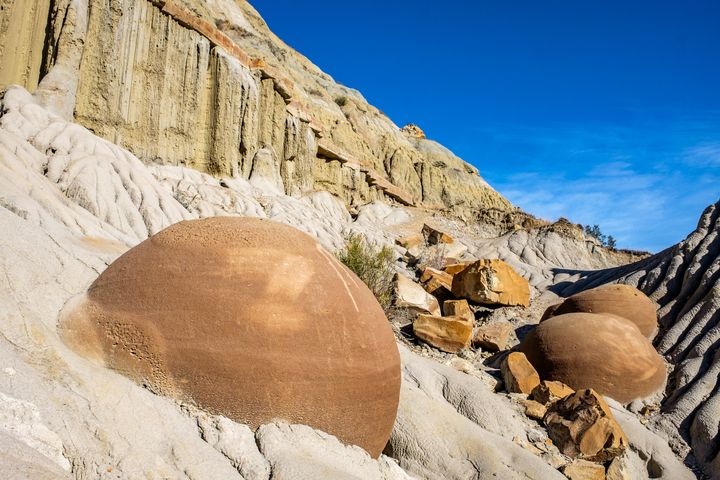
Otherwordly geology: the Cannonball Concretions in the north unit.
Watchable Wildlife
When the park was established in the 1940s, many native species of animals were at that time rare or displaced from the region. Through reintroduction efforts spanning the last 50 years, populations continue to grow as the ecosystem continues to be restored to earlier states of wildness. Black-tailed prairie dogs pop out of holes in prairie dog “towns,” howling as they alert their mates of predators—such as coyotes, which can be found everywhere on the landscape. Bison, deer, pronghorn antelope, and badgers are easy to spot; as are elk, who travel in large herds but tend to scatter in the presence of humans as this area has long been a big-game hunting ground. Theodore Roosevelt is one of the few parks that is home to wild horses, another easy-to-spot species, offering a glimpse of what early visitors to America’s wildest areas might have seen when horses roamed across the entire western half of the country.

A bison herd on Park Loop Road in the south unit of the park.
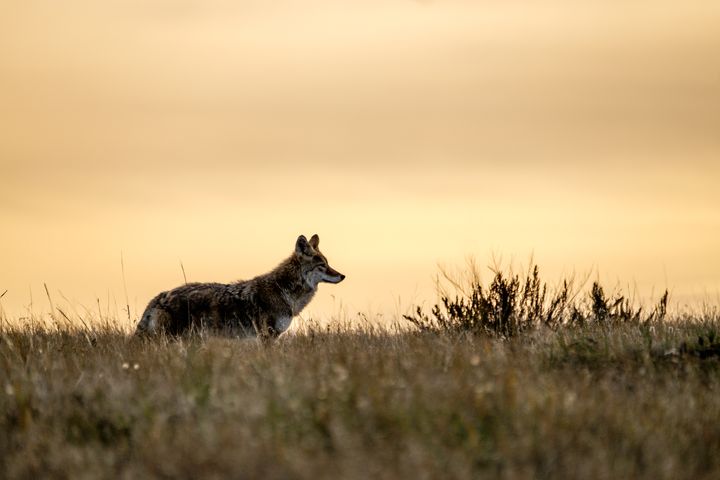
A coyote scans the landscape at dusk.
Wild Horses
Perhaps the greatest draw to the park in terms of wildlife are the wild horses, which are today protected as a cultural resource. They and their stories bring return visitors to the park each year, many of whom know the horses by name and participate in efforts to preserve their wild habitat. As the landscape is clearly well-equipped for horses, it makes sense that riding on horseback continues to be one of the most enjoyable activities in the park. But don’t plan to hop on the back of the feral horses—while they are habituated, they are not in any way domesticated. Best to enjoy their beauty from afar! If you want to travel on horseback, either bring your own or make arrangements through a guided outfit operating in the area.
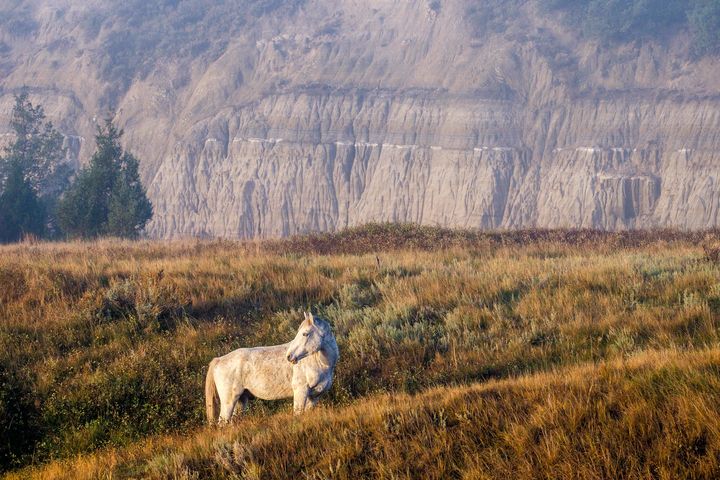
A feral horse at Theodore Roosevelt National Park, most commonly seen in the south unit.
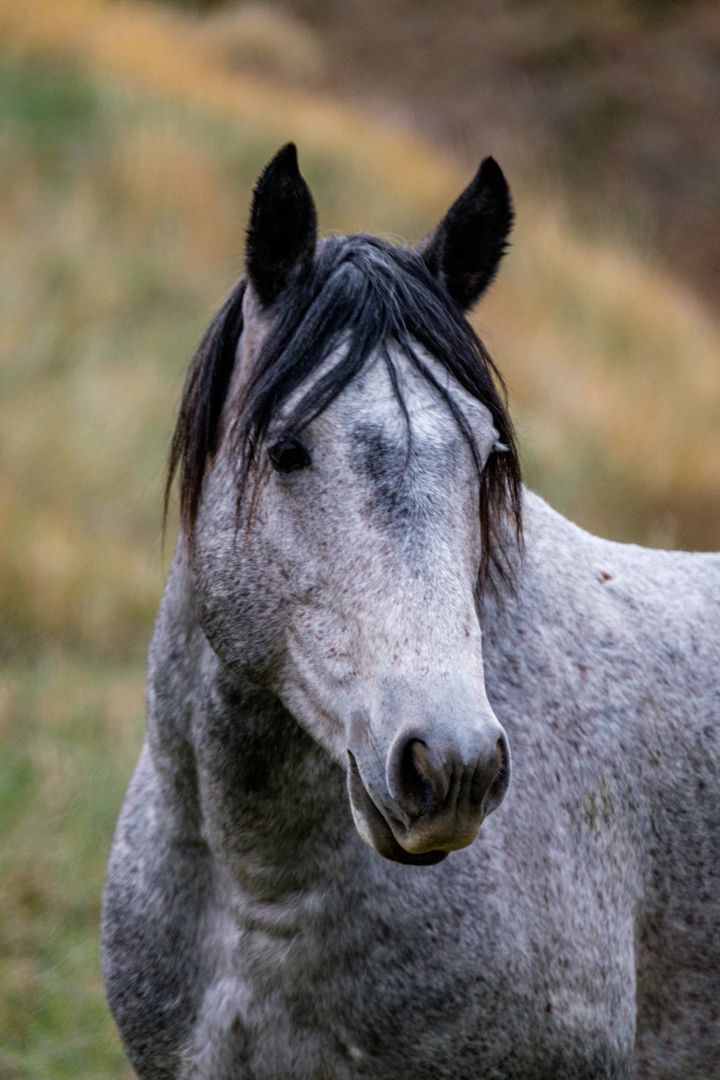
Portrait of a wild horse in Theodore Roosevelt National Park.
Beautiful Landscape Photography Opportunities
Like Badlands National Park, this is another national park where details are king. Close up views of badland formations detail the intricate textures of our planet and any photographer could get lost for days finding new ways to capture their unique patterns. Some of the most popular places to capture broader landscapes include the River Bend and Wind Canyon overlooks in the northern section of the park, which both peer onto the Little Missouri River. The sprawling view at the Painted Canyon Overlook located in the south section of the park outside the Painted Canyon Visitor Center is the most photographed and explored area of the park. For detailed looks at North Dakota's geology, head to areas with petrified forest, and to the Cannonball Concretions; for wildlife, look no further than the south unit where sightings are constant.
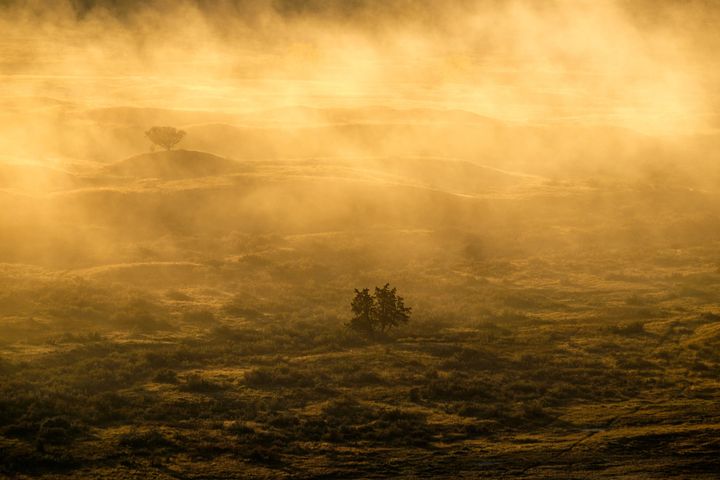
Badlands warmed by the sun in the south unit.
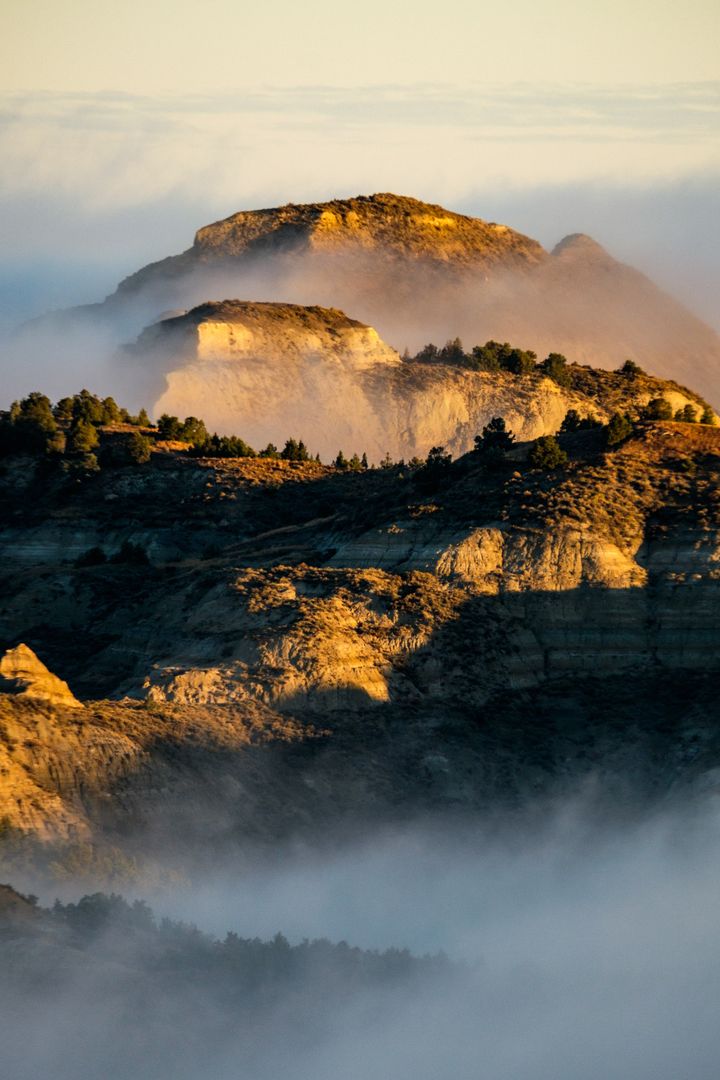
Sunrise in the south unit.
A Fascinating History
Whatever scene you are watching, you will be blessed one way or another with a view that differs only slightly from that which captured the heart and imagination of Theodore Roosevelt. His lifelong connection with the land would begin a year after his first visit in the wake of tragedy. Teddy's mother Mittie and wife Alice both died tragically on Valentine’s Day in 1884—his mother to typhoid, his wife during childbirth. It was then that he left New York for the Dakota Territory to bereave. He built the Elkhorn Ranch, took up cattle ranching and explored the banks of the Little Missouri River on horseback, employing guides he befriended during earlier hunting trips to effort the heavy lifting... but he was no slouch, Teddy's rolled up his sleeves and hauled material all day, every day until the ranch was complete. After his cattle operation continued to fail, he sold Elkhorn in 1897. After that he became a hero fighting with Rough Riders in the Spanish American War, was elected governor of New York in 1898, became Vice President of the United States in 1900, and finally, the 26th president after McKinley’s assassination in 1901. And the rest, as they say, is history—one that can be learned about and appreciated at every turn in this awesome national park.
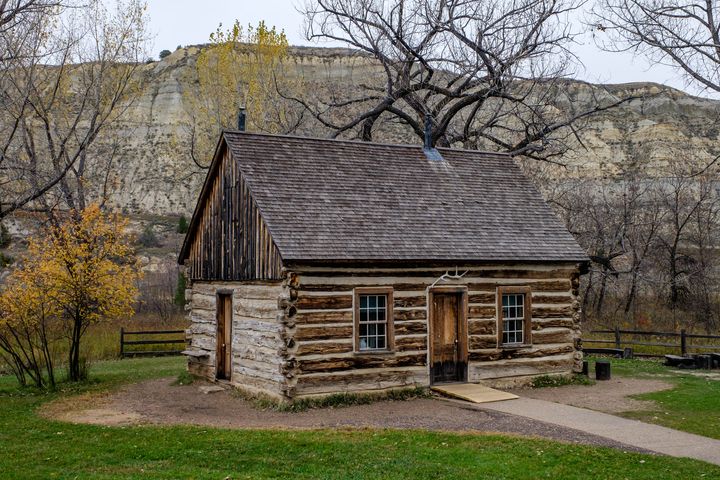
A year after his first visit in 1883, he invested $14,000 in the Maltese Cross Cabin, where he lived briefly before he built Elkhorn Ranch.
It was here that the romance of my life began. — Theodore Roosevelt
